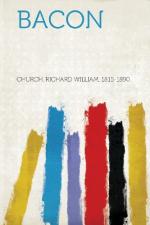The Instauratio, as he planned the work, “is to be divided,” says Mr. Ellis, “into six portions, of which the first is to contain a general survey of the present state of knowledge. In the second, men are to be taught how to use their understanding aright in the investigation of nature. In the third, all the phenomena of the universe are to be stored up as in a treasure-house, as the materials on which the new method is to be employed. In the fourth, examples are to be given of its operation and of the results to which it leads. The fifth is to contain what Bacon had accomplished in natural philosophy without the aid of his own method, ex eodem intellectus usu quem alii in inquirendo et inveniendo adhibere consueverunt. It is therefore less important than the rest, and Bacon declares that he will not bind himself to the conclusions which it contains. Moreover, its value will altogether cease when the sixth part can be completed, wherein will be set forth the new philosophy—the results of the application of the new method to all the phenomena of the universe. But to complete this, the last part of the Instauratio, Bacon does not hope; he speaks of it as a thing, et supra vires et ultra spes nostras collocata.”—Works, i. 71.
The Novum Organum, itself imperfect, was the crown of all that he lived to do. It was followed (1622) by the publication, intended to be periodical, of materials for the new philosophy to work upon, particular sections and classes of observations on phenomena—the History of the Winds, the History of Life and Death. Others were partly prepared but not published by him. And finally, in 1623, he brought out in Latin a greatly enlarged recasting of the Advancement; the nine books of the “De Augmentis.” But the great scheme was not completed; portions were left more or less finished. Much that he purposed was left undone, and could not have been yet done at that time.
But the works which he published represent imperfectly the labour spent on the undertaking. Besides these there remains a vast amount of unused or rejected work, which shows how it was thought out, rearranged, tried first in one fashion and then in another, recast, developed. Separate chapters, introductions, “experimental essays and discarded beginnings,” treatises with picturesque and imaginative titles, succeeded one another in that busy work-shop; and these first drafts and tentative essays have in them some of the freshest and most felicitous forms of his thoughts. At one time his enterprise, connecting itself with his own life and mission, rose before his imagination and kindled his feelings, and embodied itself in the lofty and stately “Proem” already quoted. His quick and brilliant imagination saw shadows and figures of his ideas in the ancient mythology, which he worked out with curious ingenuity




